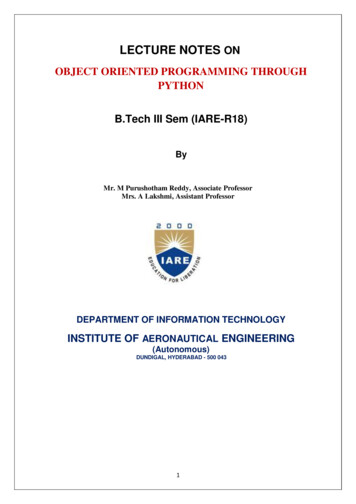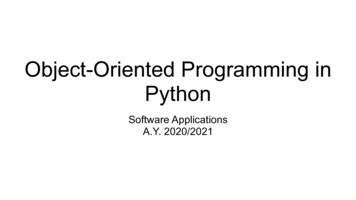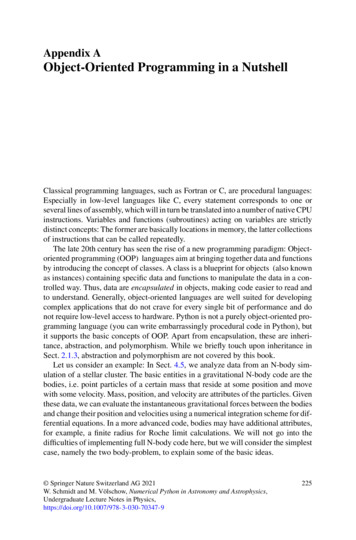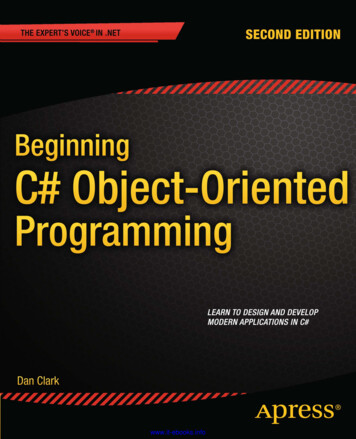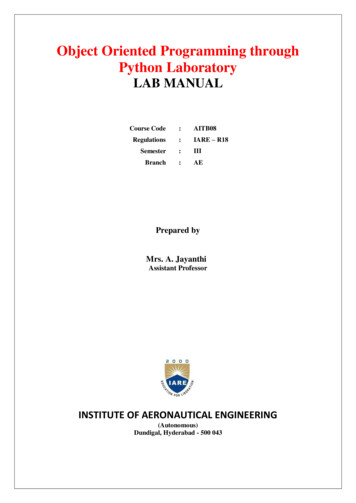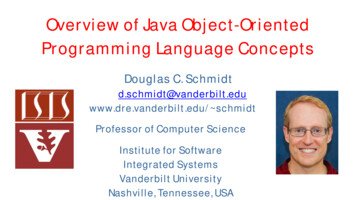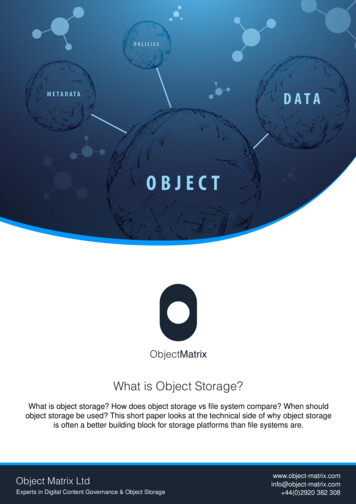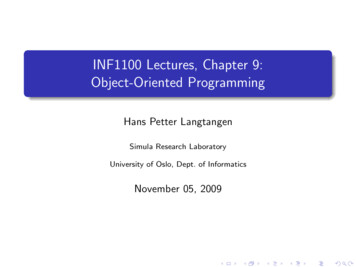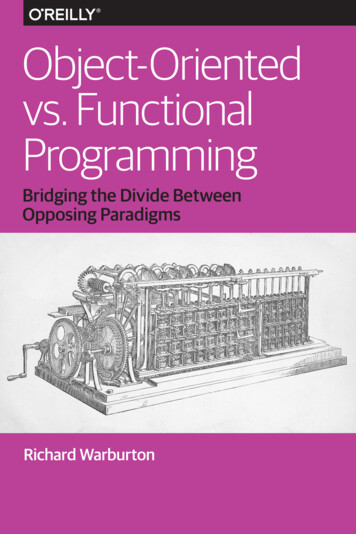
Transcription
Introduction to Object-Oriented Programming Objects and classes Encapsulation and information hiding Mental exercises Classification and exemplificationAggregation and decompositionGeneralization and specialization Inheritance Polymorphism and dynamic binding Java an example of an object-oriented programming language Program exampleHistory of JavaComparison to C/C OOP: Introduction1
Objects and ClassesMammalTwo-legsVery large brainsOmnivorous (plants meat)MammalTusksFour legsHerbivorous (plant eater)OOP: Introduction2
The Object Concept An object is an encapsulation of data. An object has identity (a unique reference) state, also called characteristics (variables) social security number (cpr), employee number, passport numberhungry, sad, drunk, running, alivebehavior (methods) eat, drink, wave, smile, kiss An object is an instance of an class. A class is often called an Abstract Data Type (ADT).OOP: Introduction3
The Class Concept A class is a collection of objects (or values) and a corresponding set of methods.A class encapsulates the data representation and makes dataaccess possible at a higher level of abstraction. Example 1: A set of vehicles with operations for starting, stopping, driving, get km/liter, etc.Example 2: A time interval, start time, end time, duration,overlapping intervals, etc.Example 3: A string, upper case, compare, lower case, etc. str.equals(otherStr) – class/Java stylestrcmp(str, otherStr) – C styleOOP: Introduction4
Encapsulation and Information Hiding Data can be encapsulated such that it is invisible to the “outside world”.Data can only be accessed via methods.DataOOP: ethodFunctionMethodProceduralClass5
Encapsulation and Information Hiding, cont. What the “outside world” cannot see it cannot depend on! The object is a “fire-wall” between the object and the “outside world”.The hidden data and methods can be changed withoutaffecting the “outside world”.Outside worldAn objectClient interfaceVisible data and methodsHidden (or encapsulated) data and methodsOOP: Introduction6
Class vs. ObjectClass A description of thecommon properties of aset of objects. A concept. A class is a part of aprogram.Object A representation of theproperties of a singleinstance. A phenomenon. An object is part of dataand a program execution. Example 1: Person Example 1: Bill Clinton, Example 2: Album OOP: IntroductionBono, Viggo Jensen.Example 2: A Hard Day'sNight, Joshua Tree, RickieLee Jones.7
Connection between Object and Class In object-oriented programming we write classes The text files we create contain classes!Static“One” Objects are created from classes A class contains a “receipe” on how to make objectsDynamic“Many”Ingrediens250 g digestive biscuits food processor125 g soft brown sugar saucepan125 g butter wooden spoon50 g raisins 18 cm sandwich tin (greased)3 tablespoons cocoa powder fridge1 egg, beaten knife25 g 1 oz2.5 cm 1 inchProcessblendbakeOOP: Introduction source http://www.icbl.hw.ac.uk/ltdi/cookbook/chocolate cake/source http://www.filflora.com8
Type and Interface An object has type and an interface.Accountbalance()withdraw()deposit() To get an object To send a messageOOP: IntroductionTypeInterfaceAccount a new Account()Account b new Account()a.withdraw()b.deposit()a.balance()9
Instantiating Classes An instantiation is a mechanism where objects are created from a class.Always involves storage allocation for the object.A mechanism where objects are given an initial state.Static Instantiating In the declaration part of aprogram. A static instance isimplicitly createdOOP: IntroductionDynamic Instantiating In the method part of aprogram. A dynamic instance iscreated explicitly with aspecial command.10
Interaction between Objects Interaction between objects happens by messages being send. A message activates a method on the calling object. An object O1 interacts with another object O2 by calling amethod on O2 (must be part of the client interface). “O1 sends O2 a message” O1 and O2 must be related to communicate. The call of a method corresponds to a function (or procedure)call in a non-object-oriented language such as C or Pascal.O1messageOOP: IntroductionmessageO3O2message11
Phenomenon and Concept A phenomenon is a thing in the “real” world that hasindividual existence. an object A concept is a generalization, derived from a set ofphenomena and based on the common properties of thesephenomena. a class Characteristics of a concept A nameIntension, the set of properties of the phenomenonExtension, the set of phenomena covered by the concept.OOP: Introduction12
Classification and Exemplification, Examples hat, 23, 34, mouse, telephone, book, 98, 45.34, hello numbers:words:23, 34, 98, 45.34hat, mouse, telephone, book, hello mouse, tyrannosaurus rex, allosaurus, elephant, velociraptor dinosaur:mammal:OOP: Introductiontyrannosaurus rex, allosaurus, velociraptormouse, elephant13
Classification and Exemplification, cont. A classification is a description of which phenomena that belongs to a concept.An exemplification is a phenomenon that covers the nonOOP: Introduction14
Aggregation and Decomposition, Example Idea: make new objects by combining existing objects. Reusing the )Dooropen()close()existing rive()new class Car “has-a” Gearbox and Car “has-an” EngineOOP: Introduction15
Aggregation and Decomposition An aggregation consists of a number of (sub-)concepts which collectively is considered a new concept.A decomposition splits a single concept into a number of(sub-)concepts.ConceptConcept Concept ConceptdecompositionaggregationConcept Concept ConceptConceptOOP: Introduction16
Generalization and SpecializationOOP: Introductionsource : www.geology.ucdavis.edu/ GEL12/dinosauria.Html17
Generalization and Specialization, cont. Generalization creates a concept with a broader scope. Specialization creates a concept with a narrower scope. Reusing the interface!Concept AConcept CspecializationgeneralizationConcept BConcept DVehicleCarHatchbackOOP: IntroductionStation carTruckSedanPickup18
Generalization and Specialization, Example Inheritance: get the interface from the general class. Objects related by inheritance are all of the same ize() Square “is-a” Shape or Square “is-like-a” ShapeOOP: Introduction19
Generalization and Specialization in ize()CircleOOP: IntroductionLineRectangle20
Polymorphism and Dynamic Bindingvoid doSomething(Shape s){s.draw(); // “magically” calls the specific classs.resize();}Circle c new Circle();Line l new Line();Rectangle r new ing(r);// dynamic binding Polymorphism: One piece of code works with all shape objects.Dynamic binding: How polymorphism is implemented.OOP: Introduction21
Benefit Generalization and Specialization Take previous Shape class hierarchy remove inheritanceremove general and abstract class ShapeOOP: ize()Circledraw()resize()Linedraw()resize()22
Code Example, Revisitedvoid doSomething(Circle c){c.draw();c.resize();}void doSomething(Line l){l.draw();l.resize();}Circle c new Circle();Line l new Line();Rectangle r new ing(r);OOP: Introductionvoid doSomething(Rectangle r){r.draw();r.resize();}void doSomething(Square s){s.draw();s.resize();}Similar codeis repeated23
Java Program Structure// comment on the classpublic class MyProg {String s ”Viggo”;/*** The main method (comment on method)*/public static void main (String[] args){// just write some stuffSystem.out.println ("Hello World"); }variablemethod headermethod body}OOP: Introduction24
Java Class Example Car/** A simple class modeling a car. */public class Car {// instance variablesprivate String make;private String model;private double price;// constructorpublic Car(String m, String mo, double p) {make m; model mo; price p;}// string representation of the carpublic String toString() {return "make: " make " model: " model " price: " price;}}OOP: Introduction25
Byte Code vs. ExecutableMyProg.javaMyProg.cppjavac MyProg.javagcc MyProg.cpp-o myprog.exeJava Class FileMyProg.classPortable Byte CodeJava Virtual MachineExecutable myprog.exeOperating SystemOperating SystemJava/C# worldC worldOOP: Introduction26
History of Java 1990 Oak (interactive television, big failure) 1994 Java (for the Internet) Main feature: "Write Once, Run Any Where" wrap the operating system so they all look the same Designed for A fresh start (no backward compatibility)“Pure” OOP: C Syntax, Smalltalk styleImprovements over C much harder to write a bad programInternet programming Very hard to create a virusRun in a web browser (and at the server)There is a speed issue (from Java 1.3 and up much better) C# Microsoft's “Java-Killer” project release 2001 Language very similar to JavaCommen-Language Runtime (CLR) supports 30 languagesOOP: Introduction27
Difference from C/C Everything resides in a class variables and methods Garbage collection bye bye malloc(), free(), and sizeof()Error and exception handling handlingNo global variables or methodsNo local static variablesNo separation of declaration and implementation Bye bye header files No explicit pointer operations (uses references)No preprocessor (but something similar)Has fewer “dark corners”Has a much larger standard library (Java Developer Kit orJDK)OOP: Introduction28
Summary Classes are “recipes” for creating objects All objects are instances of classes Encapsulation Key feature of object-oriented programmingSeparation of interface from implementationIt is not possible to access the hidden/encapsulated parts of an object Aggregation and decomposition “has-a” relationship Generalization and specialization (inheritance) “is-a” or “is-like-a” relationship Polymorpishm/dynamic binding Softening static typingOOP: Introduction29
Common Mistakes and Errors// what is ugly here?public class main {public static void main(String[] args){System.out.println(“Hello World”);}}// what is wrong here?public class MyClass {public void static main(string[] args){system.out.println(“Hello World”);}}// what is ugly here?public class MyClass {public static void main(String[] args){System.out.println(“Hello World”);}};OOP: Introduction30
Structuring by Program or Data? What are the actions of the program vs. which data does the program act on.Top-down: Stepwise program refinementBottom-up: Focus on the stable data parts then add methods Object-oriented programming is bottom-up. Programs arestructure with outset in the data. C and Pascal programs are typically implemented in a more top-downfashion.OOP: Introduction31
Pure Object-Oriented LanguagesFive rules [source: Alan Kay] Everything in an object. A program is a set of objects telling each other what to do by sending messages.Each object has its own memory (made up by other objects).Every object has a type.All objects of a specific type can receive the same messages.Java breaks some of these rules in the name of efficiency.OOP: Introduction32
OOP: Introduction 3 The Object Concept An object is an encapsulation of data. An object has identity (a unique reference) social security number (cpr), employee number, passport number state, also called characteristics (variables) hungry, sad, drunk, running, alive behavior (methods) eat, drink, wave, smile, kiss An object is an instance of an class.
